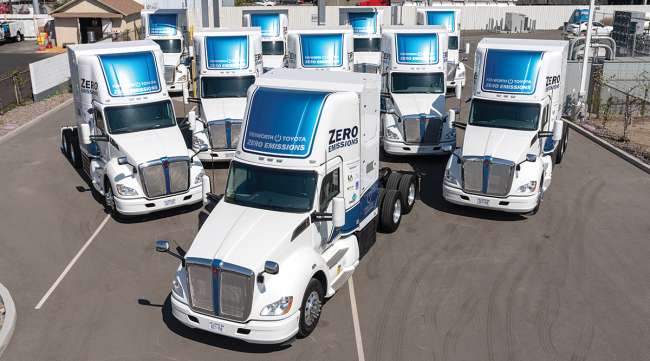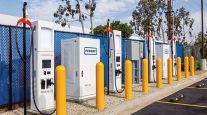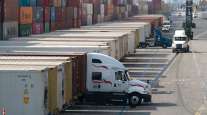Senior Reporter
California OKs Advanced Clean Fleets Regulation

[Stay on top of transportation news: Get TTNews in your inbox.]
Acknowledging that the road to implementation may be bumpy, the California Air Resources Board has unanimously approved its Advanced Clean Fleets regulation that will require some motor carriers operating in the state to begin the transition to zero-emission trucks as soon as next year.
The regulation was approved by the board April 28, despite concerns expressed by some truckers that battery or fuel-cell electric trucks may not be available as soon as required, or that there might not be an adequate electric charging infrastructure ready in time.
CARB’s goal is to have fleets operating in the state be 100% electric by 2035, 2040 or 2045, depending on size and type of truck.
The ACF rulemaking is part of a comprehensive strategy to achieve a zero-emission truck and bus fleet by 2045 everywhere feasible and significantly earlier for market segments such as last-mile delivery, public fleets and drayage applications.
Drayage trucks will be required to start transitioning to zero-emission technology beginning in 2024, with full implementation by 2035.
CARB would specifically require manufacturers to sell only electric trucks in Class 2b-8 beginning in 2036.

Randolph
“This is an absolutely transformative rule to clear our air and mitigate climate change,” CARB Chair Liane Randolph said after the vote. “We all know there are a lot of challenges, but those challenges aren’t going to be tackled unless we move forward.”
“This rule doesn’t do it all, but we are on a path,” said board member Diane Takvorian.
While strongly supported by environmental groups, the regulation has nonetheless been criticized by a number of trucking stakeholders, including American Trucking Associations.
“Fleets are extremely concerned over the regulation’s unrealistic timelines, given the unproven nature of the vehicle technology and the lack of charging and fueling infrastructure,” Mike Tunnell, ATA’s senior director of environmental affairs/research, told the board. “They are concerned that limited resources will be spent justifying exemptions, rather than delivering the nation’s freight.”
Tunnell added, “Daily round trips to and from the San Joaquin Valley arena to the state’s ports will not be able to use new trucks, because there is no daily use exemption for drayage trucks.”

Spear
“California is setting unrealistic targets and unachievable timelines that will undoubtedly lead to higher prices for the goods and services delivered to the state and fewer options for consumers,” said ATA President Chris Spear in a statement. “As it becomes clear that California’s rhetoric is not being matched by technology, we hope the Board will reverse course and allow trucking companies the freedom to choose the clean technologies that work best for their operations.”
The board was originally planned to get an implementation update report in 2028, but some board members suggested that they get updates from CARB staff annually.
“This regulation is exciting, but it’s very complicated,” said board member Davina Hurt. “I am sympathetic with the fleets, who are concerned about the cost, and whether the full job can be done with the current technology — and all the anxiety that it brings. Let’s keep it real and honest.”
California environmental regulators will offer financial and other incentives for motor carriers transitioning their fleets to zero-emission electric vehicles. However, much of the assistance in the beginning will be aimed at small fleets, certain specialty trucks and drayage operators. And in recent months, CARB staff has drawn up certain exemptions for motor carriers in the event of the unavailability of electric trucks or lack of sufficient charging infrastructure.
CA approves groundbreaking regulation to accelerate deployment of medium/heavy-duty #ZEVs to protect #PublicHealth. Advanced Clean Fleets is the world’s first mandate to end combustion truck sales & clear the air in communities with heavy truck traffic.
➡️https://t.co/rAWyIJvJb1 pic.twitter.com/lFtWNwLvqc — CARB (@AirResources) April 28, 2023
Testifying before the board in an all-day hearing on April 27, a number of trucking stakeholders expressed concerns that some classes of electric trucks might not be available in time for deadlines, that the zero-emission vehicles would add weight to trucks, that an electric truck’s range might not be far enough for some drayage and longhaul carriers, and that they fear the charging infrastructure will not be adequate.
However, several of the board members pointed to the fact that the rule will greatly impact the state’s low-income and minority communities, which they said have suffered health problems ranging from asthma to heart conditions due to pollution in California ports. Dozens of members of low-income communities testified at the hearing, urging the board to approve the rule.
Michael Lopes, an executive with Lopes Trucking Service Inc., of Modesto, Calif., told the board that he learned that zero-emission vehicles can be effective in a route application with a range of less than 150 miles, but not for longer trips.
Want more news? Listen to today's daily briefing above or go here for more info
“The ZEVs will increase costs of Class 8 day cab tractors by nearly three times,” Lopes said. “ZEVs provide only one-third of the range needed to operate over 400 miles per day and they increase the tractor’s weight by nearly 7,000 pounds.
“We are forced to ask, even with a functioning on-road charging infrastructure, how can the required daily miles be attained given the significant down time required by the driver to recharge the truck?”
Chris Shimoda, senior vice president of government affairs for the California Trucking Association, told the board that the regulation applies to vehicles that are not suited for zero-emission technology.




